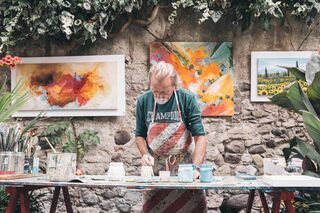Aging
New Research on Improv as Creative Aging
Improvisation helps seniors boost overall well-being, friendships, and joy.
Posted July 9, 2020

My grandmother once grabbed me by both hands and commanded, “Don’t ever get old! It’s terrible.”
Unfortunately, I can’t take her advice. It’s inevitable; we either die or get old. Those seem to be the only two options at the moment.
Fortunately, there’s more and more research being done on creative aging, which integrates arts and aging and aims to make the lives of seniors way better than terrible.
Creative Aging
Ruth H. Yamamoto’s “Improv as Creative Aging” adds improv to the growing list of activities in which seniors can engage to improve their overall well-being, build community, and have fun. Her paper starts by grounding her work on improv with other arts that researchers have already studied as creative aging.
Schneider and McCoy found that square dancing led seniors to experience joy, belonging, friendship, decreased isolation, and increased capabilities. Sabeti’s research showed that creative writing led to positive feelings and increased energy and decreased age-related stress. Finally, Cohen and Noice & Noice found that acting helped seniors improve cognitive function and memory and decrease cognitive decline.

Improv and Aging
Yamamoto places improvisation in the company of the aforementioned creative aging arts. She led a phenomenological study of six women between the ages of 65 and 80 who had participated in improv workshops for at least two semesters. Each participant was interviewed individually for 60-90 minutes and then participated in a 60-minute focus group. The aim of the interviews and focus group was to determine the impact of improvisation on the lives of the six participants.
The participants explained that improv helped them playfully combat negative stereotypes of aging. Instead of having to be serious and somber, improvisation allowed them to tap into a sense of childlike playfulness. Some of them referred to improv as adult playtime because it encouraged them to face their fears of trying something new and boosted their creativity and curiosity. In short, it was fun.

The women also talked about how improv had helped them build and maintain friendships. Aging can lead to isolation and loneliness, but these improvisers felt a sense of community because of the improv classes. The final focus group even became a kind of celebration because the six women had become such good friends due to their time improvising together.
The participants had a hard time imagining their parents’ generation doing improv because of how silly it was but agreed that it brought novelty and joy to their own lives. They were glad to be trying new things and putting themselves out there. One even said she hoped to be doing improv for the rest of her life, and that says it all. Improv had brought novelty, curiosity, friendship, and joy to the lives of these six seniors, which clearly makes improvisation a good candidate for creative aging.
Final Thoughts
I just wish my grandmother had tried improv. She had a joyous, playful, party animal side of her that her idea of aging seemed to conflict with, and improv could have helped her nurture that side of herself. I think it would have helped her combat aging by helping her challenge herself, have fun, and make new friends, and I’ve no doubt that would have made her think that getting old didn’t have to be quite so terrible after all.
References
Cohen, G. (2006). Arts and aging study: Landmark study on the effects of arts participation on an aging population. National Endowment for the Arts (NEA) (pp. 1–8).
Noice, H., & Noice, T. (2006). A theatrical intervention to improve cognition in intact residents of long term care facilities. Clinical Gerontologist, 29(3), 59–76.
Noice, H., & Noice, T. (2006). What studies of actors and acting can tell us about memory and cognitive functioning. Current Directions in Psychological Science, 15(1), 14–18.
Sabeti, S. (2015). Creative ageing? Selfhood, temporality and the older adult learner. International Journal of Lifelong Education, 34(2), 211–229.
Schneider, B., & McCoy, L. (2018). Serious leisure, play and the construction of community among older adult square dancers. Activities, Adaptation & Aging, 42(1), 54–68.
Yamamoto, R. H. (2020). Improv as Creative Aging: The Perceived Influences of Theatrical Improvisation on Older Adults. Activities, Adaptation & Aging, 1-17.


